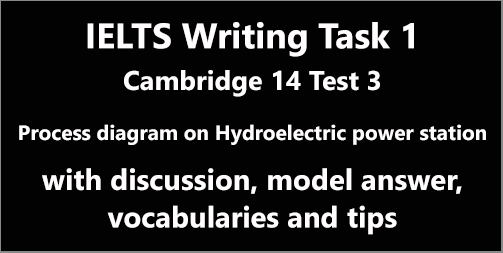This Academic IELTS Writing post focuses on a discussion on a process diagram from Cambridge 14 Test 3 on a hydroelectric power station. In this post, I’ve tried to analyse the picture step-by-step, wrote a model answer for you, discussed some vocabularies and gave some tips to write Task 1 answers in a better way. I hope this post helps you with your IELTS preparation.
Let’s have a look at the question title and the picture.
The diagram below shows how electricity is generated in a hydroelectric power station.
Analysis of the diagram:
Here are the different steps through which electricity is produced in the hydroelectric power station:
Daytime:
- Collection of river water in the high-level reservoir supported by a large dam.
- The dam is opened.
- The flow of water from the high-level reservoir to the reversible turbine.
- Collection of electricity by the generator.
- Channeling of electricity to the national grid through power lines.
- Excess water is sent to the low-level reservoir.
Night time:
- Excess water is returned from the low-level reservoir to the high-level reservoir.
- The dam is closed.
Now that we’ve analyzed the whole diagram, let’s take a look at the model answer.
Model answer:
The depicted diagram elucidates the process of electricity generation in a hydroelectric power station. Overall, the picture displays that the station works back and forth in a cycle using the river water both at night and in the daytime and the principal work of producing electricity is done by the reversible turbines in the power station.
Looking at the picture in detail, the process initiates when river water is channelled into a high-level reservoir which is supported by a large dam that intakes water. The dam remains open during the daytime and closes at night. River water flows through the reversible turbines and activates it which results in generating electricity. A generator collects the produced electricity and supplies it to the national grid through power lines. In the meantime, the excess water is directed to a low-level reservoir. At night, the excess water is pumped back from the low-level reservoir to the high-level reservoir so that it can be reused.
(159 words)
Let’s practice some vocabulary:
Depicted = depicted, describe, portrayed,
Elucidate = explain, describe,
Generation = production, making,
Display = show, demonstrate,
Back and forth = backward and forward,
Cycle = rotation,
Principal = main, major,
Reversible = usable inside out, able to be changed,
Turbine = a machine for producing continuous power in which a wheel or rotor, typically fitted with vanes, is made to revolve by a fast-moving flow of water, steam, gas, air, or other fluid.
Initiate = start, begin, kick-off,
Channelled = directed, headed,
Reservoir = tank, pool,
Remain = wait, stay,
Flow = run, stream, gush,
Activate = make active, turn on,
Supply = provide,
In the meantime = meanwhile, in the intervening time,
Excess water = surplus water, extra water,
Directed = channelled, headed,
Pump back = force back,
Reused = used again, reprocessed,
Tips for answering a process diagram:
When answering a process diagram, the first thing you should do is to mark the diagram and take some notes with your pencil. This will make your plan to write the answer in a better way. It will probably take two minutes but trust me this marking will surely help you.
Click here for a diagram showing sugar production
Click here for a diagram showing apple juice production

